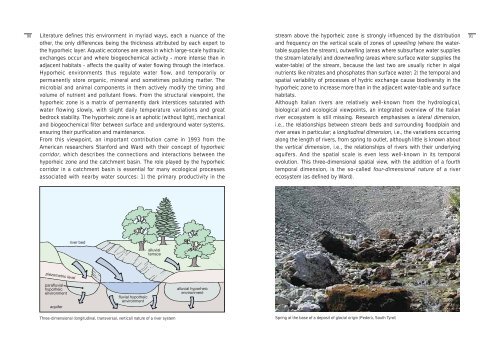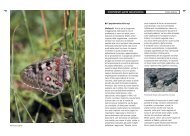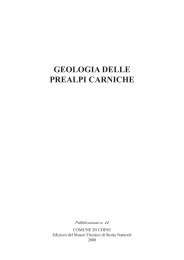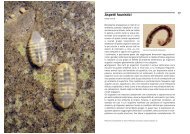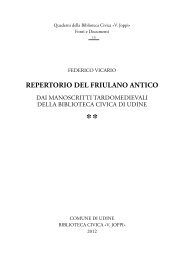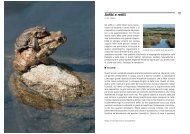Despite its inhospitable appearance and lack of any ... - Udine Cultura
Despite its inhospitable appearance and lack of any ... - Udine Cultura
Despite its inhospitable appearance and lack of any ... - Udine Cultura
You also want an ePaper? Increase the reach of your titles
YUMPU automatically turns print PDFs into web optimized ePapers that Google loves.
90<br />
Literature defines this environment in myriad ways, each a nuance <strong>of</strong> the<br />
other, the only differences being the thickness attributed by each expert to<br />
the hyporheic layer. Aquatic ecotones are areas in which large-scale hydraulic<br />
exchanges occur <strong>and</strong> where biogeochemical activity - more intense than in<br />
adjacent habitats - affects the quality <strong>of</strong> water flowing through the interface.<br />
Hyporheic environments thus regulate water flow, <strong>and</strong> temporarily or<br />
permanently store organic, mineral <strong>and</strong> sometimes polluting matter. The<br />
microbial <strong>and</strong> animal components in them actively modify the timing <strong>and</strong><br />
volume <strong>of</strong> nutrient <strong>and</strong> pollutant flows. From the structural viewpoint, the<br />
hyporheic zone is a matrix <strong>of</strong> permanently dark interstices saturated with<br />
water flowing slowly, with slight daily temperature variations <strong>and</strong> great<br />
bedrock stability. The hyporheic zone is an aphotic (without light), mechanical<br />
<strong>and</strong> biogeochemical filter between surface <strong>and</strong> underground water systems,<br />
ensuring their purification <strong>and</strong> maintenance.<br />
From this viewpoint, an important contribution came in 1993 from the<br />
American researchers Stanford <strong>and</strong> Ward with their concept <strong>of</strong> hyporheic<br />
corridor, which describes the connections <strong>and</strong> interactions between the<br />
hyporheic zone <strong>and</strong> the catchment basin. The role played by the hyporheic<br />
corridor in a catchment basin is essential for m<strong>any</strong> ecological processes<br />
associated with nearby water sources: 1) the primary productivity in the<br />
Three-dimensional (longitudinal, transversal, vertical) nature <strong>of</strong> a river system<br />
stream above the hyporheic zone is strongly influenced by the distribution<br />
<strong>and</strong> frequency on the vertical scale <strong>of</strong> zones <strong>of</strong> upwelling (where the watertable<br />
supplies the stream), outwelling (areas where subsurface water supplies<br />
the stream laterally) <strong>and</strong> downwelling (areas where surface water supplies the<br />
water-table) <strong>of</strong> the stream, because the last two are usually richer in algal<br />
nutrients like nitrates <strong>and</strong> phosphates than surface water; 2) the temporal <strong>and</strong><br />
spatial variability <strong>of</strong> processes <strong>of</strong> hydric exchange cause biodiversity in the<br />
hyporheic zone to increase more than in the adjacent water-table <strong>and</strong> surface<br />
habitats.<br />
Although Italian rivers are relatively well-known from the hydrological,<br />
biological <strong>and</strong> ecological viewpoints, an integrated overview <strong>of</strong> the Italian<br />
river ecosystem is still missing. Research emphasises a lateral dimension,<br />
i.e., the relationships between stream beds <strong>and</strong> surrounding floodplain <strong>and</strong><br />
river areas in particular; a longitudinal dimension, i.e., the variations occurring<br />
along the length <strong>of</strong> rivers, from spring to outlet, although little is known about<br />
the vertical dimension, i.e., the relationships <strong>of</strong> rivers with their underlying<br />
aquifers. And the spatial scale is even less well-known in <strong>its</strong> temporal<br />
evolution. This three-dimensional spatial view, with the addition <strong>of</strong> a fourth<br />
temporal dimension, is the so-called four-dimensional nature <strong>of</strong> a river<br />
ecosystem (as defined by Ward).<br />
Spring at the base <strong>of</strong> a deposit <strong>of</strong> glacial origin (Pederù, South Tyrol)<br />
91


